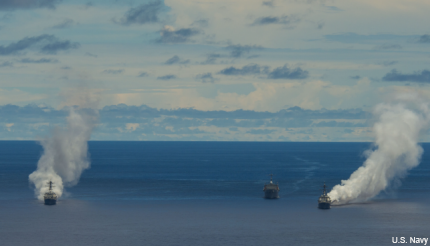Navy’s carbon-fiber clouds could make incoming missiles miss their target
The Pandarra Fog exercise shows how the clouds can absorb or diffuse radar waves from seekers on incoming missiles.

In an exercise that showed another, physical element of the emerging domain of electronic warfare, the Navy this week tested carbon-fiber clouds that can soak up radar signals and prevent an incoming missile from finding its target.
Clouds containing carbon fiber particles were generated by a device aboard ship during the exercise, which was called Pandarra Fog and was carried out by the U.S. 7th Fleet and the Navy Warfare Development Command (NWDC) June 21-25 in Guam. The particles in the clouds, formally called maritime obscurant generator prototypes, absorb or diffuse the radar waves from the seekers of incoming missiles, potentially hiding ships from those missiles as part of a layered defense, the Navy said in a release.
The exercise was the result of a joint effort, using assets from the Army, Air Force and Navy, along with the scientific efforts of NWDC, the Navy said.
"Pandarra Fog is example of the quick-turn integrated technical and tactical development the fleet is doing to master electromagnetic maneuver warfare and assure access of joint forces," said Adm. Robert L. Thomas Jr., commander U.S. 7th Fleet.
The Navy is developing a defense-in-depth approach that combines active and passive techniques in order to protect ships against a growing list of anti-ship cruise and ballistic missiles. "It is not just about the technology, but also practicing how the fleet will employ these emerging capabilities," said Capt. David Adams, who leads the 7th Fleet Warfighting Initiatives Group.
The systems, which the Navy said proved effective during the exercise, are fairly inexpensive and environmentally friendly, and can be used during typical fleet maneuvers.
Pandarra Fog also could be seen as another tool in electronic warfare, by which the military seeks to maintain control of the electromagnetic spectrum, protecting the ability of U.S. forces to use it while being able to disrupt an adversary’s use of it. Although jamming electronic signals might be the most common form of defensive EW, carbon-fiber clouds could have their place, too.
"Pandarra Fog showed the value of quickly bringing together scientific and joint forces to tackle our hardest warfighting problems," said Antonio Siordia, U.S. 7th Fleet's science advisor. "This isn't just smoke or chaff, this is high tech obscurant which can be effective against an array of missile homing systems."



